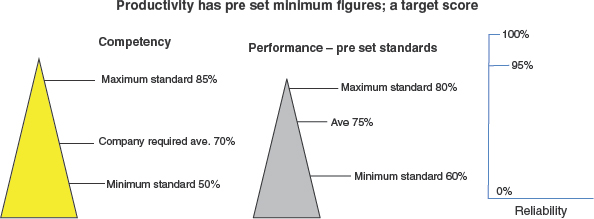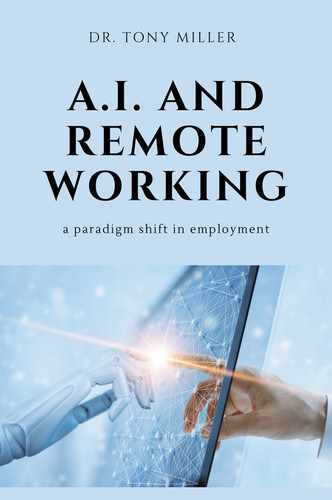The Automation of Pay and Bonus Systems to Provide a Transparent Reward System—The Shift from Paying for Knowledge to Paying for Results
We have seen in Chapter 5 how we use the performance appraisal system to gather data; you might well say what’s new; well, in fact, a lot.
AI will be able to gather the three component parts of productivity and present them for Pay and a Bonus reward and select only the performance element for Bonus. The other two elements, Competence and Reliability, will work in balance as a preventer to bonus if the minimum scores are not correct.
If this system is set up correctly, it will be initially self-funding, with no need to put artificial caps or restrictions on top performers. In the new labor market, there is going to be fierce competition for employees who have the right profile and skillset in the world of AI.
If we take our three inputs, then automatically it will slot employees into the following categories:
Poor Performers—no bonus and may face a corrective action procedure
Average performers, who could be in the lower end of the bonus structure
High Performers, who could earn up to 800 percent over basic salary.
You need to remember when you are looking at this system that you could be dealing with rapidly decreasing numbers of employees. The people who will go first are the poor performers.
If we look again at the figures discussed in Chapter 4, each of the contributors to productivity has preset minimum figures a target score.
Competency
Competency score. For employees to be eligible for bonus, their competency score must be 70 or above. Those who have their scores manipulated by managers so they can have training, as a reward will find that they have been deselected from the bonus scheme for scoring under 70.
Special provisions would need to be made for fresh graduates and college leaver’s as their competency entry score will not be high. They would get a percentage of the rate of the job until they were competent at 70 percent. Balancing all of this would be easy for an AI system.
Performance
Managers will need help here to set stretch targets and to measure them accurately. There will be undoubtedly more engagement from most employees, as they will realize the critical importance of getting high scores. Managers may be better using the (2011.dashboard) method of target setting rather than using SMART objectives. Progress on performance needs to be monitored on an ongoing basis to ensure good results are achieved. To join the bonus scheme, the minimum score we have set is 75 percent.
Once the qualifying figures are reached, the only driver for the big bonus is Performance (Miller 2010).
Reliability
Reliability, specifically sickness, is a complicated issue. The Bradford formula software seems to have got it almost right and allocates a weighting depending on the type of sickness and whether or not it’s supported by medical certification. What it is good at doing is picking up and applying a significant penalty for odd days off that are uncertified.
On the reliability chart, you will see we have a converter to convert Bradford scale scores onto a linear 0 to 100 score.
On our pro former, for presets on sickness, the target attendance is 95 percent. As with performance and competency, if you are below 95 percent, you do not qualify for a bonus (Figure 7.1).

Figure 7.1 Presetting your target scores
Teams
When structuring a bonus system for teams, precisely the same process can be used; only the team will collectively have to meet the criteria. Managers should have their bonus linked to their team’s performance but must also meet the minimum scores themselves. AI systems will enable you to have multiple-type bonus systems in the organization. This is particularly important for asymmetric designs where to optimize different departments different schemes can be used. HRs who follow traditional practices would like everyone to be on the same scheme, but the variables are limitless in the future and will be more in tune with business needs (Miller 2017d).
The score would then be used to place you into the right category for basic salary and bonus (Figure 7.2).
Also, AI would keep track of all the training costs you accumulated, and with your ongoing and updated digital footprint would be able to select you for the following:
• Removal
• A lower-level job
• Sideways move
• Promotion at the same level
• Slotted for a succession plan
Figure 7.2 How the data feeds bonus schemes
All of this would be done without bias or previous baggage from your time in the company
What’s Going to Happen to Generation Z or iGen as They Are Referred to?
There is some confusion as to who Generation Z are. Some believe that this group comprises those who were born after 1997; if this is the case, some have already entered the work base. This group is sometimes referred to as millennials, but this term can cover a wider band of people like Generation X and Generation Y. So, for our present purposes, it is best to keep these bands out and confine ourselves to Generation Z. This group is also referred to as iGen (Workforce 2017; Figure 7.3).
So, what we know about this group of people and the data about them are not particularly flattering. It is commonly believed (Sinek 2017) that this group is suffering from bad parenting. This has been brought about by some of the following factors:
1. Their parents have repeatedly told them that they are unique and as such have grown up to have more or less whatever they ask for.
2. They have grown up in a schooling system that has rewarded them even if they failed. This is made people who have failed feel worse and people who have succeeded have realized that they have had the same reward as those that failed. Some people failed in schools where they were given medals. In the cold light of day, in hindsight, this situation is ridiculous.
3. They are also the first generation to grow up in an entirely technological world. As such, it is the first generation to expect instant gratification like instant shopping, instant rewards, instant likes on social media, and so on. If they want to watch a movie, it must be instant, if they want to date, dating online is instant. So, these instant expectations will transfer to the workplace where they will expect instant gratification, instant promotion, instant success, and so on and so forth. We all know that is not the reality of the workplace.

Figure 7.3 The generations
The evidence is that this is the first group of people who are genuinely comfortable with multitasking and with using available technology to get results. Despite this comfort level, the evidence is that this group is not happy. It has a high suicide rate, some of which is linked with drug overdose and a propensity to drop out. Depression among this group is high.
There is no doubt in my mind that this group of talented people has a lot to offer to society, and they have made up 24 percent of the available workforce by 2020. This coincides precisely with the main impact of AI and reducing numbers worldwide. The issue organizations will have to grapple with if they are to involve Generation Z is how they are best utilized in the new companies that are run with AI.
The balancing act that HR and workforce planners will have to do now is to accommodate the three generations: Generation X, Generation Y, and the new intake Generation Z. Overlayered on top of these are the types of people whom you currently employ: poor performers, average performers, and talented people. Getting the mix right for your AI-led organization will be a complicated and vexing exercise. One thing we are entirely sure of is that employment numbers will start to decrease; there is no evidence that full employment will ever return. The purpose of this book has always been to help you get the best out of your existing processes and to prepare the ground for you to excel with AI. The complexities of employment, the reducing numbers of people required in the workplace, and the age balance are all factors that go beyond HR and must be sorted out by governments. Although governments have actively been talking about sorting out the problem of mass unemployment, there is little evidence that anything as yet is happening. The most prominent proponents of the change are the leaders in Silicon Valley. They have identified the massive problems that are likely to come with increasing AI and have been very vocal in their opinions about options like having universal basic income (USB). USB was described in some detail in Chapter 2. Evidence is showing that homeworks will be paid less basic pay by their employers due to the employees much lower operating costs and in some countries they will be able to claim tax breaks.

